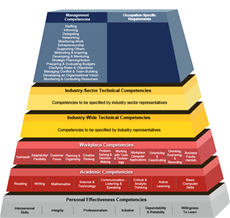Microsoft in Education Global Forum, Dubai, 2...
0 comments
 5
5 
The first question is, how many of these building blocks are we taking responsibility for in our school? And to what extent can we guarantee that every one of our graduates possesses these blocks when the walk out the door?
A recent report by the Council on Foreign Relations bases its analysis on this pyramid, and calls on all of us to pay attention to the right building blocks:
"Looking at the bottom half of the pyramid reveals why so many adults never achieve stable careers. The first layer consists of personal competencies such as dependability, integrity, and willingness to learn. The second, academic competencies, comprises the basic skills taught in school (e.g., reading, math, computer proficiency, and communications). The third layer pertains to higher-order soft skills, including teamwork, planning and organizing, working with technology, and creative thinking. The subject of most traditional workforce policy, technical competencies, only emerges in the fourth layer."
"The skills deficits in those first three layers are enormously frustrating to U.S. employers. Accord-ing to the 2003 National Assessment of Adult Literacy, 14 percent of American adults read at “below basic” literacy level, and another 29 percent read and write at only a basic prose level.15 This shortfall in the basic tasks of reading, writing, and carrying out simple arithmetic may be the largest factor holding back disadvantaged youth and adults. For example, a survey of human resource professionals conducted by the Society for Human Resource Management found that young people entering the labor market lacked important skills possessed by older workers preparing to retire: most notably, writing in English (51 percent) and professionalism/work ethic (52 percent)."
An interesting exercise is to take the building blocks on the lowest three levels of the pyramid -- these are the generic skills that the Department of Labor says every worker needs -- and estimate how much of a student's time in your school is devoted to building each one. And then go back and check off the ones your school actually assess in a formal way.
Tier One: Personal Effectiveness Competencies Interpersonal Skills Integrity Professionalism Initiative Dependability & Reliability Lifelong Learning
Tier Two: Academic Competencies Science Basic Computer Skills Mathematics Reading Writing Communication—Listening and Speaking Critical & Analytical Thinking Information Literacy
Tier Three: Workplace Competencies Business Fundamentals Teamwork . Adaptability/Flexibility Marketing and Customer Focus Planning and Organizing. Problem Solving and Decision Making Working with Tools and Technology Checking, Examining, and Recording Sustainable Practices